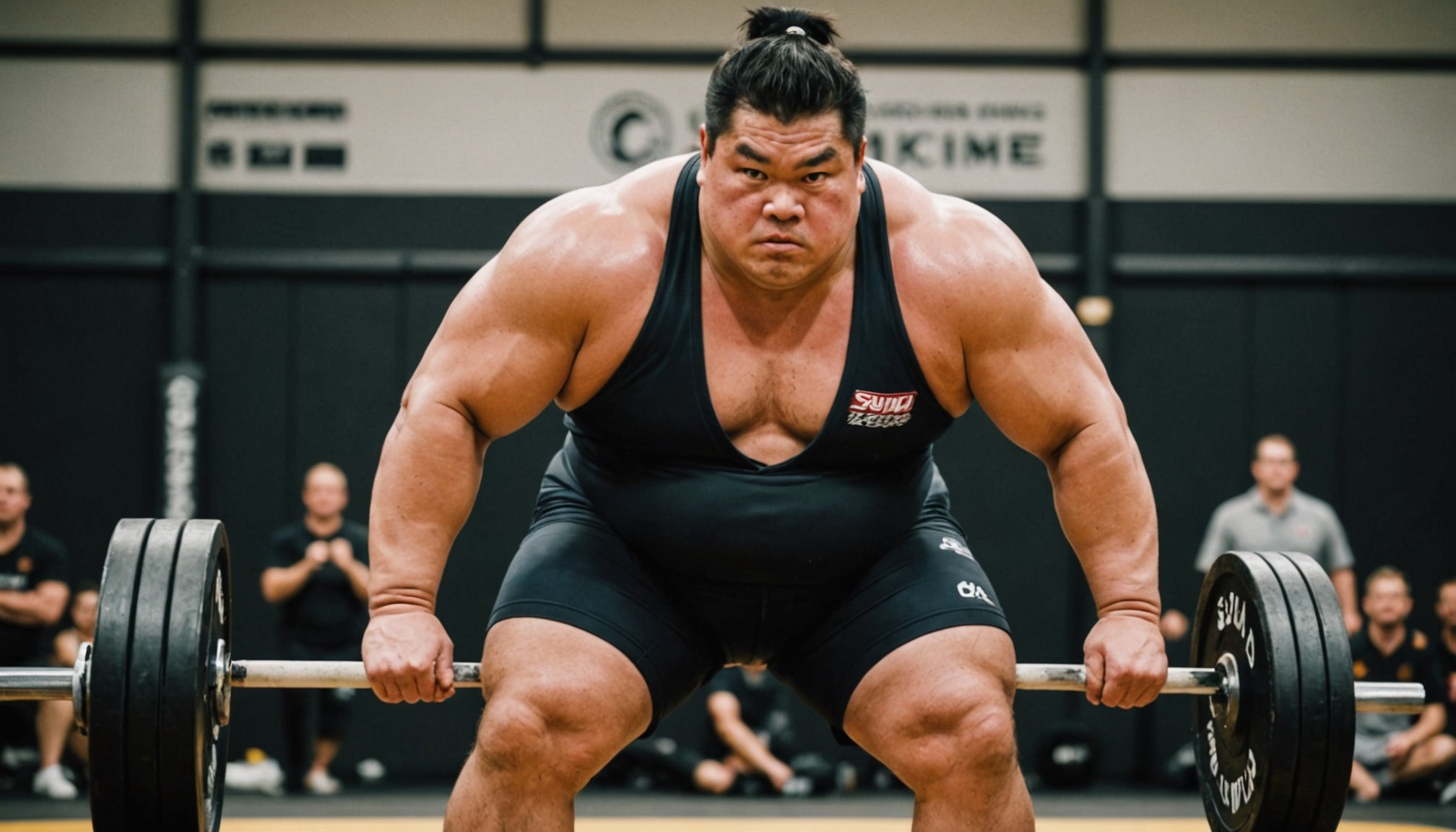Understanding the Unique Demands of Sumo Wrestling
Sumo wrestling is a sport steeped in tradition and intense physical demands. Unlike other combat sports, sumo wrestlers focus on pushing their opponent out of a circular ring or forcing them to the ground, which requires a particular blend of strength, balance, and technique.
The physical demands of sumo wrestling are quite distinct. Wrestlers, known as rikishi, must possess extraordinary lower-body strength to maintain their stance and generate powerful thrusts. Unlike in many other sports, size is an advantage in sumo, dictating a unique approach to weight management and training.
Also to see : Top Training Strategies for UK Kickboxers to Master the Roundhouse Kick
Performance in sumo wrestling hinges on tailored exercises that maintain a balance between agility and mass. Weight training for sumo wrestlers often emphasizes compound movements that build foundational strength while preserving flexibility. Unlike martial arts where weight classes dictate training, in sumo, weight gain is a strategic choice, especially at higher professional levels.
A critical facet of sumo training is endurance, as bouts can range from mere seconds to several minutes, requiring sustained exertion. Thus, wrestlers adopt a regime focused on strength, endurance, and technique development, positioning them effectively in this unique sport.
Topic to read : Top Agility Ladder Drills to Elevate Performance for MMA Fighters in the UK
Effective Weight Training Techniques for Sumo Wrestlers
Effective weight training is paramount for sumo wrestlers, as it enhances strength and performance. This section delves into the essential components of a sumo wrestler’s regimen, focusing on numerous strength exercises.
Compound Lifts
Compound lifts such as squats and deadlifts form the backbone of a wrestler’s strength-building efforts. These exercises are crucial as they target multiple muscle groups, essential for maintaining balance and power in the dohyo. Variations like the sumo squat and trap bar deadlift are ideal for sumo-specific conditioning. To optimise results, maintaining proper form—keeping the back straight and engaging the core—is imperative to prevent injuries and ensure effective resistance training.
Plyometrics
Incorporating plyometrics enhances explosive power and agility. Exercises like box jumps and lateral jumps increase explosiveness vital for pushing opponents. Including such explosive movements in a training routine, about twice a week, ensures agility improvement without overtraining.
Core Strength Training
Core stability is crucial in maintaining control and centre balance. Sumo wrestlers benefit from exercises like planks and Russian twists to strengthen this area. By integrating core workouts into a resistance training routine, wrestlers can maintain the stability required to resist pushes.
Nutritional Strategies for Optimal Performance
Understanding the role of nutrition in a sumo wrestler’s diet is crucial for performance enhancement. A balanced diet ensures that sumo wrestlers can maintain their energy levels and support rigorous training regimes.
Importance of a Balanced Diet
A well-rounded diet for sumo wrestlers includes a mix of carbohydrates, proteins, and fats. Carbohydrates are essential as they provide the energy needed for intense training sessions. Proteins are crucial for muscle growth and recovery, while healthy fats help sustain energy during prolonged workouts.
Key Nutrients for Weight Training and Recovery
Certain nutrients are particularly beneficial for weight training and muscle recovery. Omega-3 fatty acids, found in fish like salmon, reduce inflammation and speed up recovery. Vitamins B and C, and minerals like calcium and potassium, support muscle function and prevent cramping.
Sample Meal Plans for Wrestlers
Tailored meal plans are vital in meeting the nutritional demands of wrestlers. A sample meal plan might include:
- Breakfast: Oatmeal with fruit and nuts
- Lunch: Grilled chicken, brown rice, and mixed vegetables
- Snack: Greek yogurt with berries
- Dinner: Salmon, quinoa, and steamed broccoli
This structured approach balances nutrient intake, ensuring peak performance and optimal health.
Performance Tips from Experienced UK Sumo Wrestlers
Gleaning insights from seasoned UK sumo wrestlers can offer invaluable performance tips for aspiring athletes. This section shares deep dives into their training techniques, mental preparation, and supportive community resources essential for success.
Training Regimens
UK sumo wrestlers emphasize the significance of a consistent training regimen to enhance performance. Typically, training sessions occur several times a week, with each session lasting between one to two hours. Striking a balance between intensity and recovery is essential. Athletes often mention that alternating high-intensity workouts with lighter sessions or rest days assists in preventing injuries and promotes overall well-being. Such regimens are tailored to address both physical endurance and skill mastery, vital in sumo wrestling.
Mental Preparation and Focus
Success in sumo wrestling hinges significantly on mental toughness. Athletes underscore the importance of resilience, concentration, and mental preparation. Techniques like visualization, mindfulness practices, and focused breathing help improve concentration. Several wrestlers have shared personal anecdotes about overcoming nerves and pressure. These mental strategies are instrumental in staying grounded, especially during competition.
Community Support and Resources
Training within a community delivers substantial advantages. Experienced sumo wrestlers affirm the encouragement and camaraderie found in dedicated teams, and mentorship often accelerates athlete development. In the UK, several resources, from local clubs to national federations, provide platforms for training, mentorship, and competition, reinforcing the athlete’s journey.
Case Studies of Successful UK Sumo Wrestlers
Exploring the success stories of UK sumo wrestlers reveals a fascinating mix of dedicated training and unique athlete journeys. Let’s dive into some inspiring case studies.
One prominent figure is Andrew ‘The Giant’ Bennett, who rose to fame through dedication and innovation in his training methods. His journey underscores the significance of personalized training regimes tailored to an athlete’s specific needs. His emphasis on agility, alongside traditional weight training, allowed him to excel in speed-based matches.
Julie ‘Thunder’ Thompson, another noteworthy name, focused heavily on nutrition and mental conditioning. Her holistic approach contributed significantly to her success on the mat, demonstrating that achieving peak performance extends beyond mere physical prowess.
Both Andrew and Julie highlight the impact of effective weight training on enhancing their performance. The incorporation of core strengthening exercises and dynamic resistance routines has proven vital in maintaining balance and power.
The key takeaways from these journeys are clear: success in sumo wrestling requires a multifaceted approach, blending strength, agility, and mental fortitude. Aspiring sumo wrestlers can learn much from these athletes who have mastered their craft through discipline and innovation.
Effective Weight Training Techniques for Sumo Wrestlers
Tailored weight training techniques are crucial in improving sumo wrestling performance, as they address the unique physical demands of the sport. Sumo wrestlers require explosive power, agility, and balance—qualities best enhanced through customised resistance training.
Key Principles of Resistance Training
Resistance training for sumo wrestlers focuses on building both dynamic strength and functional agility. These athletes need exercises that target the legs, core, and shoulders to support powerful movements on the dohyo, or the sumo ring. Emphasising compound exercises like squats and deadlifts enhances muscle development and stamina, which are vital for maintaining leverage during matches.
Milestone Training Methods
Milestone training methods involve a combination of heavy lifting sessions and dynamic drills that build both strength and agility. Incorporating plyometrics helps increase explosive power, aiding sumo wrestlers in rapid engagement during bouts. Meanwhile, balancing exercises, such as single-leg squats, ensure that wrestlers can remain stable even in the most challenging positions. By integrating these methods into their training regimen, sumo wrestlers can develop the physical prowess necessary to excel in their sport.
Targeted Exercises for Sumo Wrestlers
Sumo wrestling, an ancient and revered martial art, requires immense strength, agility, and balance. Tailored exercises are crucial for sumo wrestlers to develop these attributes, focusing particularly on lower body strength, upper body strength, and core stability.
Lower Body Strength Development
In the domain of sumo, lower body strength is paramount. Exercises such as deep squats, lunges, and leg presses are staple Sumo Wrestler Exercises. These exercises target quadriceps, hamstrings, and calves, essential for powerful leg drives. To stave off training plateaus, incorporating variations like sumo squats and step-ups can be beneficial. These not only diversify training but also fine-tune the wrestler’s power and explosiveness in bouts.
Upper Body Strength Progression
Upper body strength progression is crucial for effective grip and thrusting techniques. Strength training exercises like bench presses and shoulder presses are commonly used. They particularly engage pectoral, deltoid, and tricep muscles. To enhance traditional techniques, adopting push-up variations, such as clapping push-ups, ensures improved arm explosiveness.
Core Stability and Balance Exercises
Core stability is pivotal for maintaining balance in the ring. Engaging in exercises like planks and rotational twists will enhance dynamic equilibrium. These exercises emphasize abdominal and oblique muscles, supporting stability during the ferocious combats. Furthermore, incorporating traditional Japanese training methods can provide a cultural touchstone while enhancing balance.
Nutritional Strategies for Optimal Performance
In the world of sumo wrestling, nutrition plays a pivotal role. Understanding the right balance of essential macronutrients is crucial for energy production and recovery. Proteins, fats, and carbohydrates provide the fuel that sumo wrestlers need to maintain their strength and stamina during bouts. Carbohydrates are particularly important in a performance diet as they help restore glycogen levels, allowing for sustained energy during matches.
Timing meals around training sessions can significantly enhance performance. Consuming a carb-rich meal or snack approximately 1-2 hours before training can optimize energy levels. Post-training, it’s essential to incorporate proteins and carbohydrates to aid in muscle recovery and replenish energy stores. Such strategic timing ensures that athletes remain in peak condition throughout their training cycles.
Hydration is another quintessential aspect of sumo wrestling nutrition. Given the intense physical exertion, maintaining adequate hydration helps in thermoregulation and reduces the risk of injury. Water and electrolyte-rich beverages are ideal for keeping the body’s hydration levels balanced. This focused approach to nutrition not only supports physical demands but also enhances overall performance in sumo wrestling.
Physiological Demands of Sumo Wrestling
Sumo wrestling is a sport that requires distinct physical attributes and intense training to meet its unique athletic demands. Understanding the physiology behind this ancient sport offers insights into the preparation and endurance needed by athletes.
A sumo wrestler must possess a combination of strength, agility, and balance. While weight is often emphasized, muscle mass and flexibility are crucial for effective performance. These athletes need to maintain a specific weight class to optimize their training and competitive edge. This often involves a rigorous regimen, including specialized diets and exercises, to build the necessary muscle bulk and explosive power.
With such demanding physical requirements, sumo wrestlers are prone to certain injuries and physical stressors. Common issues include knee injuries, back pain, and joint strain, largely due to the repetitive motions and considerable force exerted during matches. Addressing these potential injuries is essential, often requiring preventive measures such as targeted physical therapy and expert medical care.
Understanding these physiological demands can help develop strategies to enhance performance while minimizing the risk of injury, ensuring wrestlers remain at the peak of their physical capabilities.
Expert Tips and Safety Considerations
Sumo Training Safety is paramount whether you’re a novice or a seasoned wrestler. Additionally, integrating Expert Training Tips can elevate your performance while ensuring safety.
Consultation with Coaches and Experts
Collaborating with experienced coaches is imperative. Expert guidance provides customised training regimens that cater to individual needs. This tailored approach prevents common pitfalls and enhances learning efficiency.
Injury Prevention Strategies
Prioritise injury prevention by incorporating structured warm-ups and cool-downs into your routine. These activities are essential in preparing muscles and reducing injury risks. Besides, mastering proper techniques protects against strains and sprains.
Importance of Recovery and Rest
Recognising signs of overtraining is vital. Fatigue, persistent soreness, and decreased performance indicate the need for rest. Balancing training intensity with ample recovery time fosters overall development.
- Safe practice guidelines are essential. Ensure training partners adhere to agreed protocols to minimise accidents.
- Incorporate mental health in training. Address stress through mindfulness and relaxation techniques to bolster mental resilience.
Preparing for competitions requires a gradual increase in intensity with frequent recovery periods. Such a balanced approach can significantly improve performance while maintaining overall wellbeing in sumo training.
Training Schedules for Sumo Wrestlers
Sumo wrestlers follow a rigorous training schedule designed to build both strength and technique. A typical week-long regimen may start with early mornings filled with traditional exercises. Traditional sumo exercises include “shiko” stomping and “teppo” striking, aiming to improve balance and muscle memory. This is followed by practice bouts, which simulate real-match conditions.
Adjustments in the workouts are crucial, as training loads must be tweaked depending on the competition timetable. Wrestlers often increase their intensity and frequency of workouts leading up to major tournaments but may ease off slightly to recuperate right before the matches.
Incorporating cross-training is a modern addition to the otherwise traditional routine. Places emphasis on muscle development and endurance through activities like swimming or strength training. Finally, flexibility work can play a crucial role in keeping wrestlers agile and minimizing the risk of injury. Techniques such as yoga or dynamic stretching might be employed for this purpose. Thus, a sumo training schedule is a balanced blend of tradition with contemporary practices aimed for optimal performance in the ring.











